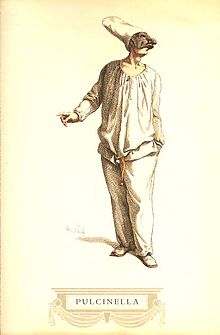Pulcinella

Pulcinella ( Neapolitan Pulecenella , Italian Policinello , French Policinelle or Polichinelle) is originally a figure of the southern Italian and Neapolitan folk theater.
history
From southern Italy the mask of Pulcinella gradually spreads northwards with the traveling troops of the Commedia dell'arte . However, it is believed that it has (pre) Roman origins in the figure of the Muccus of the Atellan Theater . At the same time, related masks were created from this figure. In the German-speaking countries, for example, it influenced or served as a template for the characters Hanswurst , Kasper in the German or Kasperl in the Alt-Wiener Volkstheater , in England for Punch and Jack Pudding, Jan Klaassen in the Netherlands, Mester Jockel in Denmark and Petruschka in Russia. From the 17th century, however, this figure faded and was increasingly pushed off the stage.
Surname
The name means "little chick" (Italian pulcino for "chick" with the diminution -ella , crossed with pullo for "dark, black"). Possibly the name can be traced back to an actor named Puccio d'Agnello , who is said to have come across wandering theater troupes as a farmer with a nimble tongue. Another thesis is that a certain Puccio d'Anielle, a farmer from Acerra , with a tanned face and long nose appears in a painting by Annibale Carracci , which inspired the actor Silvio Fiorillo to invent the mask.
Typology
Since the time of the Renaissance the figure has been to be found mostly cunning, cunning, coarse and at the same time simple-minded and foolish, voracious servant of peasant origin. The figure mostly had a hump, often a long bird's nose, which gave it a fox-like expression. Her original costume was made of coarse fabric in green, brown or red colors. This gradually changed to a white costume with wide sleeves, a black half mask and a pointed hat.
effect
Goethe speaks admiringly of this figure: "One of the main fun of this lowly comical personage [...] was that at times on the stage he seemed to completely forget his role as an actor." However, the "theater" of Pulcinella was " of such a reputation that no one in good company boasts of having been in it. ”And further:“ The Pulcinell is usually a kind of living newspaper. Everything that happened in Naples during the day can be heard from him in the evening. These local interests, combined with the low folk dialect, make it almost impossible for strangers to understand it. ” Franz Grillparzer also mentions him in the notes of his trip to Italy in May 1823 in Naples.
Igor Stravinsky created a monument ( Pulcinella ) for him in 1920 with his music for the ballet named after this figure . Josef Strauss composed his Policinello Quadrille as Opus 21 in 1856 and as early as the 18th century, Policinello was the name of an anonymous composition for Johann Anton Losy von Losinthal .
In Acerra, Italy, this figure was set up in its own museum, the Museo di Pulcinella.
Web links
- Official website of the Museo Pulcinella (Italian)
Individual evidence
- ^ Language, comparison of languages, etymology, languages: Pulcinella
- ^ Nils Jockel: Commedia dell'Arte between streets and palaces. Hamburg 1983
- ↑ "Pulcinella mangiamaccheroni" at TaccuiniStorici.it , last accessed on January 6, 2014 (Italian)
- ^ A b Johann Peter Eckermann: Conversations with Goethe in the last years of his life, February 14, 1830, quoted from the Gutenberg-DE project
- ^ Adalbert Quadt : Guitar music from the 16th to 18th centuries Century. According to tablature ed. by Adalbert Quadt. Volume 1-4. Deutscher Verlag für Musik, Leipzig 1970 ff .; 2nd edition ibid 1975-1984, volume 3, p. 31.